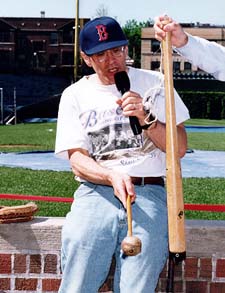 |
|
Put a CORK in it Corked bats probably make no difference, but physicists will argue the point (gladly) by Mike Perricone Sammy Sosa says he picked up his corked bat by mistake. To physicist Alan Nathan, the real mistake was thinking cork would make a difference in the first place. Nathan, a baseball lifer (Boston Red Sox) and professor of physics at the University of Illinois at Urbana-Champaign, delivers the message in his widely-cited writing and lecturing on the physics of baseball: the reason to cork a bat is to lighten it, so you can swing it faster; but making it lighter by reducing the mass in the barrel wipes out any benefit from increased bat speed. "In the absence of some trampoline-type effect from either the cavity in the bat or from the filler material," Nathan said, "my conclusion is that there is no substantial effect from corking the bat with regards to a long fly ball, where one of the goals is to have as high a batted-ball speed as possible. That is, the beneficial effect of having a lighter bat (which can give higher bat speed) is essentially canceled by the reduced mass of the bat in the vicinity of the impact point, which is then less effective at transferring energy to the ball." If anyone stands to benefit from corking, it could be the singles hitter, not the slugger. "If you are a 'contact' hitter who doesn't swing the bat as hard as you can," Nathan said, "then the beneficial effect of a lighter bat gives more bat control and probably leads to a higher batting average."
Hitters have gone so far as to jam compressed high-bounce "superballs" into the barrel of a bat, looking for a trampoline effect—but then watched with chagrin when the bat split and the superballs spilled out. Nathan said a trampoline effect needs more study, but he’s never found one. "I have done measurements on a hollowed wood bat without the filler and have concluded that there is no trampoline effect, nor did I expect any," Nathan said. "To get a trampoline effect, you need to have energy stored in the compression of the bat and effectively returned to the ball. Even the hollowed-out bat is far too stiff to store any appreciable energy, so there is no trampoline effect there. Cork is highly unlikely to produce any trampoline effect because it is at the other extreme—too compressible. Although it can store elastic energy, it has much too long a time constant to 'spring back' at the right time to return that energy to the ball. So the stored energy gets lost. Again, no trampoline effect." Since the bat-ball impact lasts about 1/1000th of a second, "you would need a material with a spring constant a lot less than that of the bat but a bit more than that of the ball," Nathan said. "I don't know where superballs fall on this scale. I am having some bats specially made so I can investigate this experimentally. There are labs where one can go to test bats under high-speed conditions. I hope to have all the answers then. Meanwhile, I can't see any advantage to Sosa in using a corked bat." But what if the cork is not placed in the barrel, but is inserted down near where the bat begins to taper toward the handle? That's the hiding place revealed when Sosa's bat split open. "A lighter bat moves faster," said Fermilab's Peter Limon, former Technical Division head and another long suffering Bosox lifer. "This gives the batter a few more milliseconds to count the stitches on a fastball. It may also help transfer energy to the ball. Remember, the problem is not defined by a free-swinging bat. This bat is attached to Sammy Sosa, to his wrists and his shoulders. If the bat is corked near the handle, it shifts the sweet spot out, which is probably a good thing if you're Sammy Sosa." And now we've got a rhubarb. "I can't understand how corking the bat at the tapered region does anything other than weaken the bat," Nathan countered. "It does nothing to affect the ball-bat collision, which occurs in the barrel of the bat. It probably does not affect the batter's swing speed, since the mass was removed too close to the hands to matter. The moment of inertia of the bat around the hands, which is what mostly determines the swing speed, hardly changes." But Limon wondered about the possible cumulative effect of an ounce here, an ounce there over the long haul of a six-month season-and that difference can be physical or psychological. "You don't need much of an edge," Limon said. "As Crash Davis put it so clearly, one more hit a week will turn a .250 hitter into a star and a .300 hitter into a superstar. Plus, even a psychological advantage can make a difference when you're facing a major league pitcher throwing 98 miles an hour." Either way, since perception usually strikes out reality, cork is here to stay. "I guess I don't buy it," Nathan said. "But it is fun to argue about these things." ON THE WEB: Alan Nathan, The Physics of Baseball: www.npl.uiuc.edu/~a-nathan/pob/ Fermilab Colloquium—Baseball: It’s Not Nuclear Physics (or is it?): www.npl.uiuc.edu/~a-nathan/pob/fnal/index.htm |
| last modified 7/7/2003 email Fermilab |
FRLsDFx9eyfrPXgV
